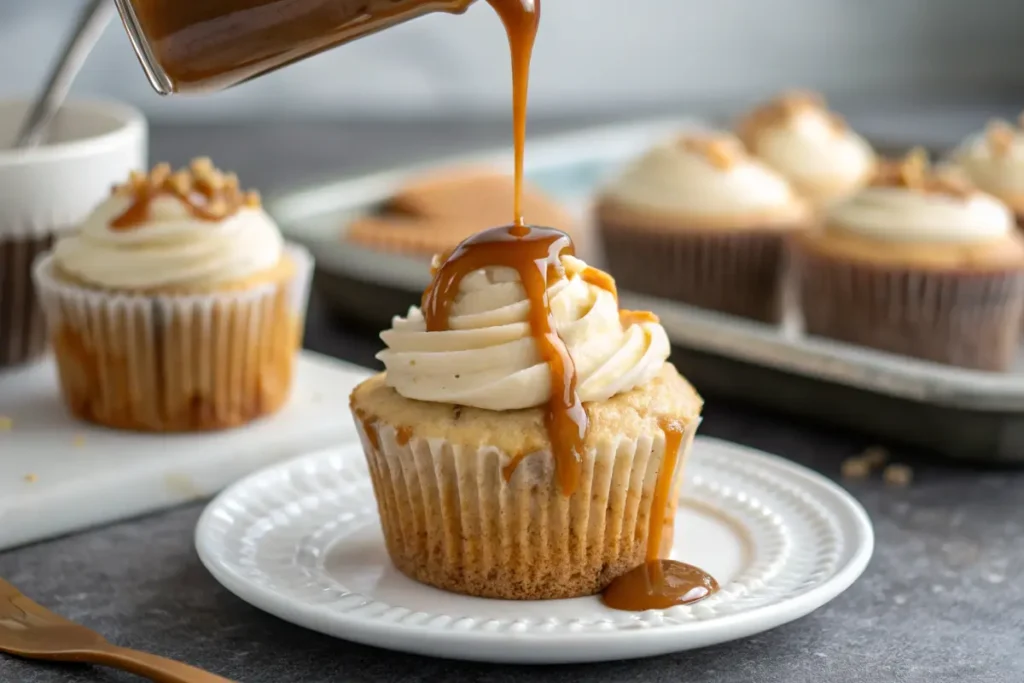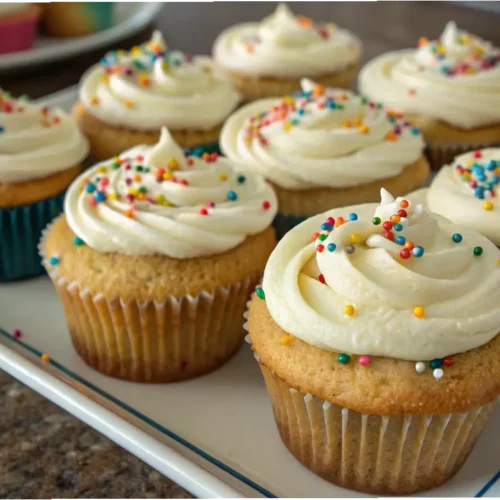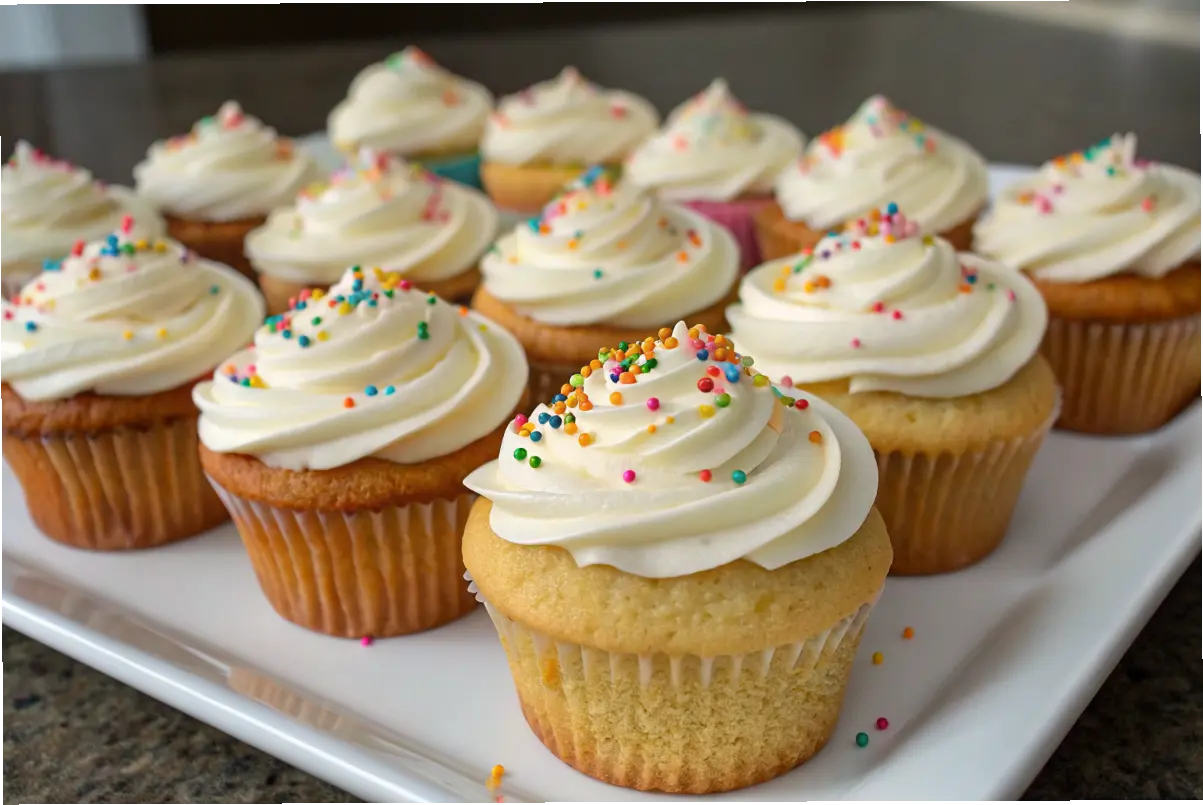Written by Sarah Miller
Gluten-free baking has come a long way, and these gluten-free cupcakes prove that you don’t have to sacrifice texture or flavor when ditching wheat flour. Whether you have a gluten intolerance, are baking for someone with celiac disease, or simply want to try something new, this recipe delivers soft, fluffy, and perfectly sweet cupcakes every time.
Many people assume that gluten-free cupcakes are dry, crumbly, or have an unusual aftertaste. However, with the right ingredients and baking techniques, you can create cupcakes that taste just as good—if not better—than their traditional counterparts. The key lies in choosing the right flour blend, balancing moisture, and using the best mixing techniques to create a light and tender crumb.
In this guide, we’ll walk you through everything you need to know about baking gluten-free cupcakes, from the best flours to use to foolproof techniques that prevent sinking and dryness. Whether you’re a seasoned gluten-free baker or trying it for the first time, this recipe will soon become a favorite in your kitchen.
For more gluten-free baking inspiration, check out Strawberry Purée for a fresh fruit topping or explore protein-packed treats like Protein Pudding.
What Makes Gluten-Free Cupcakes Different?
Gluten-free cupcakes differ from traditional cupcakes in both texture and baking techniques. Since they lack gluten, which provides elasticity and structure, they require special ingredients and methods to achieve the perfect light, moist, and fluffy consistency.
Key Differences Between Gluten-Free and Regular Cupcakes
| Feature | Gluten-Free Cupcakes | Regular Cupcakes |
|---|---|---|
| Texture | Can be crumbly or dense if not made properly | Light, airy, and naturally elastic |
| Structure | Needs binding agents like xanthan gum | Gluten naturally holds structure |
| Moisture | Requires extra fats (butter, oil) or yogurt | Retains moisture due to gluten |
| Flavor | Depends on the flour blend used | Classic wheat flavor |
| Mixing Method | Gentle mixing to prevent toughness | Standard creaming or one-bowl method |
Since gluten-free batters behave differently, you need the right flour blend, proper mixing techniques, and added moisture to prevent dry or crumbly cupcakes.
Why Do Some Gluten-Free Cupcakes Taste Different?
- The flour blend you use determines the flavor. Some flours, like almond or coconut flour, add nutty undertones.
- If xanthan gum or a binding agent isn’t used, the texture may feel grainy or dry.
- Overmixing the batter can cause dense or gummy cupcakes.
To achieve the perfect gluten-free cupcake, you need the right ingredients. Let’s explore what goes into making the best gluten-free cupcakes.
Essential Ingredients for the Perfect Gluten-Free Cupcakes
Creating moist, fluffy gluten-free cupcakes requires the right balance of ingredients. Since traditional wheat flour is not used, alternative ingredients help mimic the texture, structure, and moisture needed for a delicious cupcake.
Key Ingredients and Their Functions
| Ingredient | Purpose |
|---|---|
| Gluten-Free Flour Blend | Acts as the base, replacing wheat flour. A mix of rice, almond, or oat flour works best. |
| Xanthan Gum | Provides elasticity and structure, preventing crumbling. |
| Baking Powder & Baking Soda | Adds lift and prevents dense cupcakes. |
| Eggs (or Egg Replacements) | Binds ingredients and keeps cupcakes light. |
| Milk (or Dairy-Free Alternative) | Ensures a moist texture. Almond, oat, or coconut milk works well. |
| Butter or Oil | Adds richness and keeps the cupcakes soft. |
| Sugar or Honey | Sweetens the cupcakes and helps with browning. |
| Vanilla Extract | Enhances the flavor of the cupcakes. |
Best Gluten-Free Flours for Cupcakes
Choosing the right flour is essential for achieving the perfect soft and fluffy texture. Some flours work better than others, and some need to be blended for optimal results.
| Flour Type | Texture & Best Use |
|---|---|
| Rice Flour | Light texture but can be slightly gritty. Works best in blends. |
| Almond Flour | Adds moisture and a subtle nutty flavor. Great for dense cupcakes. |
| Oat Flour | Provides a soft texture and mild flavor. Works well in blends. |
| Coconut Flour | Very absorbent, requires extra liquid. Best mixed with other flours. |

For the best results, use a gluten-free all-purpose flour blend that combines different flours for a balanced texture. If making your own, try mixing rice flour, oat flour, and a small amount of almond or coconut flour.
Now that we have the right ingredients, let’s move on to the step-by-step guide for baking the perfect gluten-free cupcakes.
Step-by-Step Guide to Baking Gluten-Free Cupcakes
Baking gluten-free cupcakes requires the right techniques to achieve a soft, fluffy texture. Follow these steps to ensure your cupcakes turn out light, moist, and perfectly baked every time.
Step 1: Prepare the Batter
- Preheat the Oven – Set your oven to 350°F (175°C) and line a cupcake tin with paper liners.
- Mix the Dry Ingredients – In a large bowl, whisk together your gluten-free flour blend, xanthan gum, baking powder, baking soda, and salt to evenly distribute ingredients.
- Cream the Butter and Sugar – In another bowl, beat butter (or oil) and sugar together until light and fluffy. This step helps aerate the batter.
- Add the Eggs and Vanilla – Mix in eggs (or egg replacement) and vanilla extract, beating until smooth.
- Alternate Adding Dry and Wet Ingredients – Gradually add the dry ingredients to the butter mixture, alternating with milk or dairy-free milk, mixing gently.
- Do Not Overmix – Overmixing can lead to dense, gummy cupcakes. Stir just until combined.
Step 2: Bake the Cupcakes
| Cupcake Size | Baking Time | Check for Doneness |
|---|---|---|
| Standard (12-count) | 18–22 minutes | Insert a toothpick – it should come out clean. |
| Mini Cupcakes | 10–12 minutes | Light golden top and firm to touch. |
| Jumbo Cupcakes | 25–30 minutes | Toothpick should come out clean. |
- Fill the cupcake liners about 2/3 full to allow room for rising.
- Bake in the center rack to ensure even cooking.
- Cool completely before frosting to prevent melting.

Now that your cupcakes are perfectly baked, let’s address common baking issues and how to prevent gluten-free cupcakes from sinking in the middle.
How to Prevent Gluten-Free Cupcakes from Sinking
One of the most common issues when baking gluten-free cupcakes is sinking in the middle. This happens due to improper ingredient balance, mixing, or baking techniques. Here’s how to avoid sunken cupcakes and ensure they rise evenly.
Common Causes and Solutions
| Issue | Cause | Solution |
|---|---|---|
| Cupcakes sink after baking | Too much liquid or too little structure | Use a gluten-free flour blend with xanthan gum |
| Dense or gummy texture | Overmixing the batter | Stir gently and avoid excess mixing |
| Cupcakes collapse while cooling | Underbaking | Bake until a toothpick comes out clean |
| Flat tops instead of rising | Not enough leavening agents | Ensure proper amounts of baking powder and soda |
Pro Tips for Perfectly Risen Cupcakes
Use room temperature ingredients – This helps the batter mix evenly and rise properly.
Measure flour correctly – Spoon it into the measuring cup and level it off (don’t pack it).
Avoid opening the oven too early – This can cause temperature fluctuations and sinking.
Let cupcakes cool in the pan for 5 minutes, then transfer to a wire rack to prevent excess moisture.
With these techniques, your gluten-free cupcakes will rise beautifully and stay fluffy. Now, let’s explore frosting ideas and toppings to make your cupcakes even more delicious!
Frosting Ideas and Toppings for Gluten-Free Cupcakes
A delicious frosting takes gluten-free cupcakes to the next level! Whether you love classic buttercream, rich ganache, or dairy-free alternatives, the right topping enhances both flavor and texture.
Best Frostings for Gluten-Free Cupcakes
| Frosting Type | Best Flavor Pairings | Dairy-Free Option? |
|---|---|---|
| Classic Buttercream | Vanilla, chocolate, lemon | No (but can be made with vegan butter) |
| Cream Cheese Frosting | Carrot, red velvet, pumpkin | No (but can use dairy-free cream cheese) |
| Chocolate Ganache | Chocolate, peanut butter, mocha | Yes (with coconut milk) |
| Whipped Coconut Cream | Vanilla, berry, tropical flavors | Yes |
| Peanut Butter Frosting | Chocolate, banana, caramel | Yes (with almond or oat milk) |
Toppings to Elevate Your Cupcakes
Fresh Fruit: Add strawberries, blueberries, or raspberries for a refreshing touch.
Sprinkles: Use gluten-free sprinkles for color and texture.
Crushed Nuts: Almonds, walnuts, or pecans provide a crunchy contrast.
Drizzles: Try honey, caramel, or melted chocolate for an extra layer of indulgence.

Pro Frosting Tips
Let cupcakes cool completely before frosting to prevent melting.
Use a piping bag for a professional-looking swirl.
Add a pinch of salt to balance sweetness in buttercream or ganache.
Now that your cupcakes are beautifully decorated, let’s go over how to store and reheat them to keep them fresh.
Storing and Reheating Gluten-Free Cupcakes
Proper storage keeps gluten-free cupcakes fresh, moist, and delicious for days. Follow these tips to maintain their texture and flavor.
How to Store Gluten-Free Cupcakes
| Storage Method | Best For | How Long? | Tips for Best Results |
|---|---|---|---|
| Room Temperature | Frosted or unfrosted cupcakes | 1–2 days | Store in an airtight container to prevent drying out. |
| Refrigerator | Frosted cupcakes | 4–5 days | Keep in a sealed container to retain moisture. Let sit at room temp before eating. |
| Freezer | Unfrosted cupcakes | Up to 2 months | Wrap tightly in plastic wrap and store in a freezer bag. |
How to Reheat Gluten-Free Cupcakes
| Method | Steps | Best For |
|---|---|---|
| Microwave | Heat for 10–15 seconds on medium power | Quick reheating |
| Oven | Warm at 300°F (150°C) for 5–7 minutes | Restoring freshly baked texture |
| Room Temperature | Let sit for 30 minutes before serving | Preventing dryness |
Pro Storage Tips
Add a piece of bread to the storage container to keep cupcakes moist.
If freezing, frost cupcakes after thawing for the best texture.
For extra freshness, store cupcakes separately from frosting and assemble when ready to eat.
Now that you know how to keep your cupcakes fresh, let’s explore common mistakes to avoid in gluten-free baking to ensure perfect results every time!
Common Mistakes to Avoid in Gluten-Free Baking
Baking gluten-free cupcakes requires special techniques to achieve the perfect texture. Avoid these common mistakes to ensure your cupcakes turn out soft, moist, and delicious every time.
Top Gluten-Free Baking Mistakes and How to Fix Them
| Mistake | Why It Happens | How to Fix It |
|---|---|---|
| Using the Wrong Flour | Single flours like almond or coconut don’t provide enough structure. | Use a gluten-free all-purpose blend for the best texture. |
| Skipping Xanthan Gum | Without a binder, the cupcakes may crumble. | Add xanthan gum or guar gum to mimic gluten. |
| Overmixing the Batter | Creates a dense or gummy texture. | Mix gently until just combined. |
| Underbaking | Can cause sinking in the middle. | Bake until a toothpick comes out clean. |
| Too Much Liquid | Gluten-free flours absorb liquid differently. | Measure carefully and adjust as needed. |
| Not Letting the Batter Rest | Helps the flour hydrate for a better texture. | Let the batter sit for 15–20 minutes before baking. |
Pro Tips for Foolproof Gluten-Free Cupcakes
Use room temperature ingredients to help the batter mix evenly.
Weigh flour using a kitchen scale for accurate measurements.
Test different flour blends to find your favorite texture and taste.
Now that you know what mistakes to avoid, let’s answer some frequently asked questions about gluten-free cupcakes to clear up any doubts!
FAQs About Gluten-Free Cupcakes
Do gluten-free cupcakes taste different?
Gluten-free cupcakes can taste just as delicious as regular ones! The key is using a high-quality gluten-free flour blend and adding enough moisture from ingredients like butter, oil, or milk. Some gluten-free flours, like almond or coconut flour, add a subtle nutty flavor.
Is Betty Crocker cupcake icing gluten-free?
Yes, most Betty Crocker cupcake icings are gluten-free, but always check the label for cross-contamination warnings if you have celiac disease or a gluten sensitivity.
Are Reese’s Cupcakes gluten-free?
While Reese’s peanut butter cups are gluten-free, Reese’s branded cupcakes (like store-bought packaged versions) may contain gluten. Always check the ingredients list before consuming.
Which flour is best for gluten-free cakes?
A gluten-free all-purpose flour blend is the best option for baking soft, fluffy cupcakes. A mix of rice flour, potato starch, and xanthan gum works well. Almond flour and oat flour also add a nice texture but should be mixed with other gluten-free flours.
Why do gluten-free cupcakes sink in the middle?
Cupcakes may sink due to too much liquid, underbaking, or overmixing. To prevent sinking:
Measure flour properly to maintain the right consistency.
Bake until golden brown and test doneness with a toothpick.
Let the batter rest before baking to improve structure.
Now that your questions are answered, let’s wrap up with a final conclusion on why you’ll love this gluten-free cupcake recipe!
Why You’ll Love This Recipe
Gluten-free cupcakes don’t have to be dry, dense, or flavorless! With the right ingredients, techniques, and gluten-free flour blends, you can create soft, fluffy, and moist cupcakes that rival traditional recipes. Whether you’re baking for dietary reasons or simply looking for a new dessert, this easy gluten-free cupcake recipe guarantees delicious results every time.
By following baking tips like using xanthan gum for structure, measuring flour correctly, and avoiding overmixing, you’ll get perfectly risen cupcakes with a tender crumb. Plus, with countless frosting and topping options, you can customize these cupcakes to fit any occasion!
Ready to start baking? Give this gluten-free cupcake recipe a try and see how simple and delicious gluten-free baking can be! For more dessert ideas, check out Strawberry Purée for a fresh fruit topping or try Protein Pudding for a high-protein treat.

Gluten-Free Cupcakes
Equipment
- Mixing bowls
- Measuring cups and spoons
- Hand mixer or stand mixer
- Muffin tin (12-cup capacity)
- Cupcake liners
- Wire rack (for cooling)
- Rubber spatula (for folding ingredients)
- Whisk (for dry ingredient mixing)
- Ice cream scoop or spoon (for evenly filling cupcake liners)
Ingredients
- 1 ½ cups gluten-free all-purpose flour blend
- 1 teaspoon xanthan gum omit if your flour blend already contains it
- 1 teaspoon baking powder
- ½ teaspoon baking soda
- ¼ teaspoon salt
- ½ cup unsalted butter softened (or coconut oil for dairy-free)
- ¾ cup granulated sugar
- 2 large eggs room temperature
- 1 teaspoon vanilla extract
- ½ cup milk or dairy-free alternative such as almond or oat milk
Instructions
- Preheat the oven to 350°F (175°C) and line a muffin tin with cupcake liners.
- In a medium bowl, whisk together the gluten-free flour blend, xanthan gum, baking powder, baking soda, and salt.
- In a large mixing bowl, cream the butter and sugar until light and fluffy (about 2–3 minutes).
- Add eggs and vanilla extract, mixing until well incorporated.
- Alternate adding the dry ingredients and milk, starting and ending with the dry ingredients. Mix gently until just combined. Avoid overmixing.
- Fill cupcake liners about ⅔ full with the batter.
- Bake for 18–22 minutes, or until a toothpick inserted in the center comes out clean.
- Let cupcakes cool in the pan for 5 minutes, then transfer to a wire rack to cool completely.
- Once cooled, frost with buttercream, cream cheese frosting, or dairy-free frosting of choice.
- Serve and enjoy!
Notes
Flour Blend: A mix of rice flour, oat flour, and almond flour works well if making your own blend.
Storage: Store cupcakes at room temperature for 2 days, in the fridge for 4–5 days, or freeze unfrosted cupcakes for up to 2 months.
Reheating: Microwave for 10–15 seconds to soften before serving.
